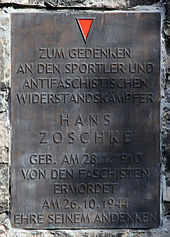Hans Zoschke
Johannes "Hans" Zoschke (born January 28, 1910 in Landsberg an der Warthe , † October 26, 1944 in Brandenburg-Görden ) was a German resistance fighter against National Socialism .
Life
Hans Zoschke grew up in Lichtenberg with his grandparents and played football at the local sports club Empor , where he met Werner Seelenbinder , Fritz Riedel and other workers' athletes. After attending school, he managed to get by as an unskilled worker because there was no money for training. From the age of 17, Zoschke earned his income as a seaman ( trimmer , stoker, sailor). From 1931 to 1936 he was unemployed. After 1933 Zoschke took an active part in the fight against National Socialism and, without being a member of a communist association, joined a resistance group led by Beppo Römer , which later united with the organization around Robert Uhrig . He took part in Marxist training courses, distributed illegal anti-fascist literature, pasted anti-war posters in the Lichtenberger Kiez and hid Alfred Kowalke in his apartment in 1941 . Zoschke was arrested in February 1942, sentenced to death on September 5, 1944 by the People's Court under Roland Freisler along with five co-defendants (including Erich Lodemann , Otto Schmirgal , Werner Seelenbinder and Walter Siemund ) and executed on October 26 in the Brandenburg-Görden prison. His urn was transferred to the Friedrichsfelde central cemetery on August 4, 1946 and buried there in what is now the Socialist Memorial (urn collecting grave by the large porphyry plaque on the right side of the curtain wall).
Hans Zoschke was married to Elfriede "Friedel" Zoschke and had a daughter. During his imprisonment he wrote a. a. also poems that he could smuggle out of prison.
Honors
- In honor of Zoschke, the stadium on Normannenstrasse in Berlin-Lichtenberg was renamed the Hans-Zoschke Stadium in 1952. Since 2009 it has been called the HOWOGE Arena "Hans Zoschke" .
- At the same time, a memorial plaque was installed on the stadium to commemorate Hans Zoschke. The plaque was renewed in the 1970s and additionally provided with a red triangle in the center above the inscription, with which the politically persecuted in the concentration camps were marked. In 2005 the plaque was stolen by strangers, so it had to be replaced. A new plaque was unveiled on January 18, 2007. The metal plaque is approx. 40 cm × 60 cm, the capital letters of the first name and surname have been set larger, it now bears the inscription: “In memory of the sportsman and anti-fascist resistance fighter Hans Zoschke, geb. on January 28, 1910, murdered by the fascists on October 26, 1944, in honor of his memory " (see photo)
- In the Lichtenberger Rathausstrasse 8, the Polytechnic Oberschule located there had been named Hans Zoschkes since the late 1970s (since 1999 the school at the town hall ). Here stood a memorial stone created by the sculptor Karl Lau in the early 1970s , which, in addition to the inscription Hans Zoschke 1910–1944, contained a relief portrait of the honoree (see upper picture). - The memorial stone was in poor condition and was removed during the total renovation of the building complex in 2010/2011.
- In Berlin-Karlshorst , the former Ohm-Krüger-Strasse was renamed Johannes-Zoschke-Strasse on January 14, 1976 .
literature
- Memorials and memorials of the labor movement in Berlin-Lichtenberg. Berlin, 1973.
- Hans Maur: Reminder, memorial and memorial sites of the labor movement in Berlin-Lichtenberg. District management Berlin of the SED, Berlin 1982. DNB 850792193
Web links
- Johannes-Zoschke-Strasse. In: Street name lexicon of the Luisenstädtischer Bildungsverein (near Kaupert )
References and comments
- ↑ Johannes Zoschke on www.berlin.friedparks.de
- ^ Hans-Rainer Sandvoss: Resistance in Lichtenberg and Friedrichshain . Edited by the German Resistance Memorial Center 1998. Page 162.
- ↑ The angle was part of the organizational symbol of the VVN founded in February 1947 and from 1953 of the committee of anti-fascist resistance fighters of the GDR. The logo identified the publisher of the plaque.
- ↑ Inspection in January 2011
| personal data | |
|---|---|
| SURNAME | Zoschke, Hans |
| ALTERNATIVE NAMES | Zoschke, Johannes (real name) |
| BRIEF DESCRIPTION | German resistance fighters against National Socialism |
| DATE OF BIRTH | January 28, 1910 |
| PLACE OF BIRTH | Gorzów Wielkopolski (Brandenburg Province) |
| DATE OF DEATH | October 26, 1944 |
| Place of death | Brandenburg prison |

